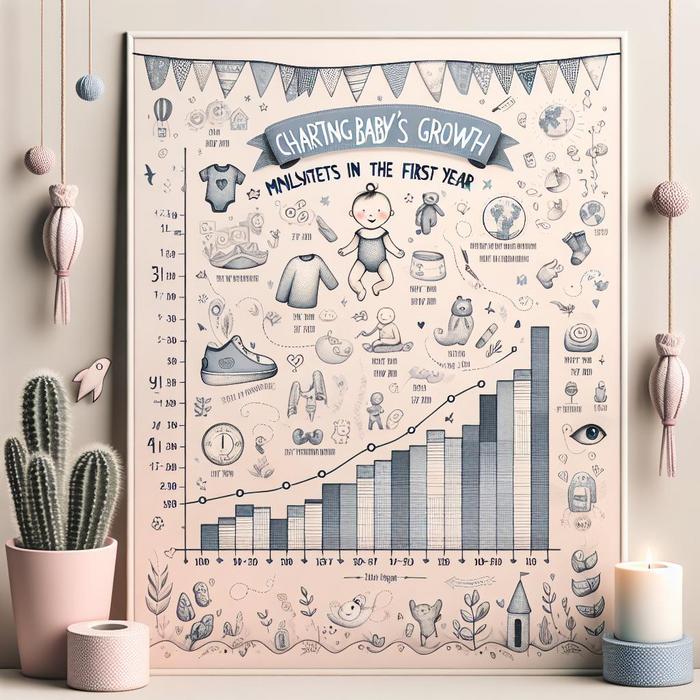Understanding Baby Growth Chart
Navigating the first year of your baby’s life can be a thrilling journey, marked by the wonder of watching them grow and develop before your eyes. The stages of development are precious milestones that will make you immensely proud. One tool that can help you track this progress is a baby growth chart.
What is a Baby Growth Chart?
A baby growth chart is a standardized tool used by pediatricians worldwide to monitor children’s physical growth in the crucial first year. It documents the baby’s weight, length, and head circumference, indicating how these dimensions compare to other infants of the same age and sex. Monitoring these critical measures with a growth chart will provide an excellent snapshot of your baby’s development and health.
Not only does it give you a sense of pride watching your child grow, but it also assists healthcare professionals in making informed decisions. They can ensure your little one is growing appropriately and intervene if growth patterns suggest potential issues.
Key First-Year Milestones
Babies achieve a multitude of milestones during their first year. Keeping track of these developmental progressions keeps you informed and proudly immersed in your baby’s world. Let’s dig into some of these key first-year milestones:
Physical Growth
During the first year, babies typically triple their birth weight and double their length. Typically, growth is most rapid in the first six months, then slows somewhat in the second half of the year.
Motor Development
Expect exciting progress in motor skills development. This includes milestone moments like holding up their head independently, rolling over, sitting without support, and even starting to crawl or walk.
Social and Emotional Development
Babies develop a strong attachment to their parents or primary caregivers. Expect heart-melting milestones such as the first smile, laughter, and even the first word.
Intellectual Development
Your baby will start to explore the world around them, learning cause and effect, recognizing familiar faces, and beginning to use objects for their intended purpose.
How to Use a Baby Growth Chart
A growth chart requires regular measurements of your baby’s weight, length, and head circumference. These measurements are typically taken during common pediatric visits and plotted on the chart. As parents, you’ll feel a sense of pride each time a new measurement is recorded.
Remember, the growth chart serves as a guide, not a definitive measure of your child’s health or development. Each baby is unique and may not follow the exact pattern shown on the chart.
Tracking Baby’s Development Beyond Physical Growth
While physical growth is vital, tracking baby development isn’t just about measurements. It’s also about observing the emergence of skills and abilities, and fostering a nurturing environment where your baby can thrive.
This can include creating a perfect nursery that stimulates their senses or introducing activities into their routine that boost growth and development.
A Timely Reminder
Remember, children grow and develop at their own pace. Milestone charts and physical growth charts should be seen as guides, not rigid rules. Your child may reach some milestones ahead of others and be slower in certain areas – and that’s perfectly okay.
As you journey through these first-year milestones, take time to savor each one. Charting your baby’s growth is a wonderful process, filled with joy, surprise, and immense pride. It is an opportunity to marvel at the miracle of development, bonding you and your child in a unique and special way.
Baby Milestones: What to Expect in the First Year?
If you are a new parent, you must be curious about your little one’s development. Babies grow at an impressive rate, accomplishing numerous milestones in their first year. Some key milestones you can expect are:
- At 3 months, babies usually start raising their heads and chests (neck control) and can give sweet smiles.
- By 6 months, they may begin to roll over and may have the first appearance of a tooth.
- At 9 months, many babies master the skill of sitting without support.
- At 12 months, many can stand on their own and may even take their first steps.
However, remember that not all babies develop at the same pace. Some might achieve certain milestones earlier than others. The most critical pointer is steady progression, not speed.
Importance of a Growth Chart
A growth chart is essential as it provides a standard measure for evaluating your child’s growth over time. It allows you to see how your child’s growth (weight, length, and head circumference) compares to other children of the same age and sex. Besides, it provides vital information to healthcare professionals, enabling them to detect any abnormal growth trends early. Early detection can facilitate prompt intervention, ensuring your child’s optimal health.
Resources for Tracking Baby’s Milestones
Fortunately, there are several resources available for parents to track their child’s development. These can include apps, books, websites, and guides. Here are a few links to get you started:
- MiKidsMatter offers a comprehensive guide detailing the expected milestones of infants.
- The CDC provides a detailed checklist of milestones for children up to one year of age.
- Healthline outlines the stages of baby’s development from birth.
A Final Word
Remember that your baby’s growth chart and development milestones are simply guides to help you monitor your baby’s progress. They should not induce stress or create unnecessary competition. Every baby grows at their own pace, so don’t rush them or compare them with others.
Your paramount responsibility is to provide a loving and supportive environment for your child. Celebrate every milestone, no matter how small, and ensure you are there to support your baby in their exploration of the world around them.
A Marvelous Journey Ahead
Enjoy the fabulous journey of parenthood that lies before you. The first year of a child’s life brings considerable changes and marvelous milestones. Embrace them all with love, patience, and a camera at hand to capture these enduring memories.

